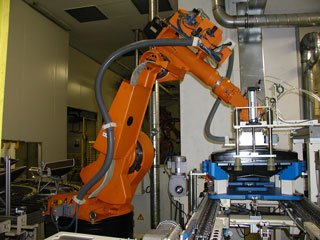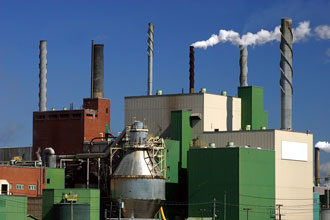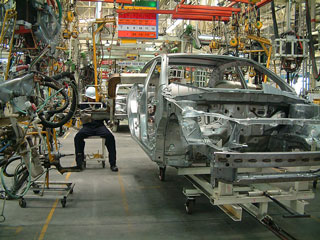Manufacturing Directory
 >
Mfg - Manufacturing
>
Mfg - Manufacturing
 Simply defined, manufacturing is any industry in which products are made
using raw materials and labor in a systematic fashion. Manufacturing
was initially done by hand. Today, most modern manufacturing is
done with the assistance of automated machines.
Simply defined, manufacturing is any industry in which products are made
using raw materials and labor in a systematic fashion. Manufacturing
was initially done by hand. Today, most modern manufacturing is
done with the assistance of automated machines.
Manufacturing comprises three processes: assembly, extraction, and alteration. Assembly is the process by which parts are combined to make a product. An example is a car, when many parts — doors, wheels, and windows, for example — are combined to make one product. Extraction is a process during which something is removed from a raw material. An example would be gasoline, which is removed from crude oil. Finally, alteration is when you take a raw material and remodel it so that it becomes something else. A good example of alteration is sawing trees, which would then be used for wood.
 Manufacturing has been around for as long as people have been on the
earth. As trade routes were discovered and the world became
smaller, new methods of manufacturing where developed in order to meet
the demand for traded manufactured goods. As early as the 14th
century, factories were built to manufacture goods such as clothing,
gunpowder, paper, and cast iron. At this point, most manufacturing
was done by hand, with simple tools.
Manufacturing has been around for as long as people have been on the
earth. As trade routes were discovered and the world became
smaller, new methods of manufacturing where developed in order to meet
the demand for traded manufactured goods. As early as the 14th
century, factories were built to manufacture goods such as clothing,
gunpowder, paper, and cast iron. At this point, most manufacturing
was done by hand, with simple tools.
The first modern-type factories appeared during the middle of the 18th century in England, during the Industrial Revolution. These earliest factories were mostly used to manufacture textiles. Slowly, but surely, machines began to replace manual labor. One of the first and most well-known machines, the cotton gin, was invented by Eli Whitney in 1793, and was designed to mechanically remove cotton fibers from the seed in a faster, more effective way. The steam engine, developed by Thomas Newcomen, James Watt, and Richard Trevithick in England, and by Oliver Evans in America, allowed the building of factories away from water sources, which had previously been needed to power machines.
 In 1798, Eli Whitney developed the concept of interchangeable parts,
which made it possible to produce items more quickly, and also meant that
if items were broken, they could be repaired without having to make
a custom part or replace the entire product. Interchangeable
parts quickly led to the concept of assembly lines, in which goods were
assembled in systematic steps. As soon as one stage of the item was
complete, it was passed on to the next station, where the next stage was
completed. To make the assembly line run faster, Henry Ford
introduced the conveyor belt in 1913.
In 1798, Eli Whitney developed the concept of interchangeable parts,
which made it possible to produce items more quickly, and also meant that
if items were broken, they could be repaired without having to make
a custom part or replace the entire product. Interchangeable
parts quickly led to the concept of assembly lines, in which goods were
assembled in systematic steps. As soon as one stage of the item was
complete, it was passed on to the next station, where the next stage was
completed. To make the assembly line run faster, Henry Ford
introduced the conveyor belt in 1913.
When the development of reliable railroads meant that materials could be brought from near and far, this created a need for more industrial labor. After World War II, when inflation was high and the amount of factory workers had grown, organized unions that protected the rights of factory workers began to spring up. These unions allowed factory workers to negotiate for better working conditions and better wages.
Manufactured products are generally broken up into two categories: durable goods and non-durable goods. Durable goods comprise goods that are designed to last for a long period of time, such as cars and appliances, while non-durable goods comprise items with a relatively short lifespan, such as clothing, food, and paper.
In the Regional Directory, manufacturer listings are grouped into Mfg categories.
Manufacturer Directories and Resources
- ThomasNet
Buyers and engineers from private industry, government, and the military rely on this online industrial destination website to find manufacturers, distributors, and service providers.
www.ThomasNet.com - Hoovers
This D&B company delivers comprehensive information and analysis about the companies, industries, and people that drive the United States economy.
www.Hoovers.com - Manufacturers' News
Compiler and publisher of state manufacturer directories and databases. Manufacturers' News Incorporated (MNI) is a one-stop source for information about American manufacturers.
www.ManufacturersNews.com - Global Sources
Creates, manages, and delivers information for trading partners, helping buyers and suppliers do business in a global economy.
www.GlobalSources.com - TradeKey
This online marketplace connects traders with worldwide manufacturers, wholesalers, importers and exporters.
www.TradeKey.com